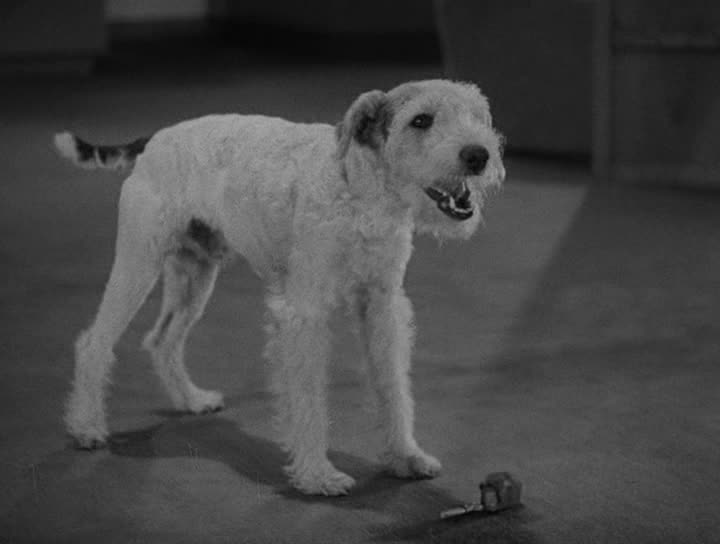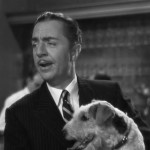After the Thin Man

1936![]()
Story by Dashiell Hammett
Screenplay by Albert Hackett and Frances Goodrich
Directed by W. S. Van Dyke

Nick and Nora Charles return to San Francisco as heroes, their solving of a murder exploits big news as San Francisco has never had any crime, ever. Okay, maybe there were a few crimes in San Francisco, but the Charles are famous thanks to the power of media making heroes. Of course, the fun can’t last, and soon Nick and Nora are drawn into a brand new murder mystery. Never fret, there are plenty of wacky characters and real dangers along the way, with Nick and Nora quipping all the while.
It’s almost literally right after The Thin Man, which took place over Christmas, and it’s now New Year’s Eve. That keeps the festive atmosphere without retreading the Christmas theme. There is a surprise welcome home party happening at Nick and Nora’s house, which means the house is packed full of people who have no idea who Nick and Nora Charles even are, nor who recognize them when they come in. A guy hilariously welcomes them inside and explains he doesn’t know who the Charles are, and advises them to just fake it like he’s doing. They go along with it, dancing together to the kitchen, where the house staff actually does recognize the pair.
More than any of the other films, After the Thin Man is aware of the class differences between Nick and Nora. Nora was born into wealth, while Nick married into it. Despite their differences, the pair are equally willing to hang out with anyone from any class strata. Nick has a constant stream of lower class reformed criminals that he runs into that are all wanting to be buddy-buddy, while Nora’s rich relatives treat Nick like a pariah, especially ironic considering the guy Aunt Katherine’s daughter Selma ended up married to.

One of the biggest draws to After the Thin Man is Jimmy Stewart, who knocks it out of the park and whose performance will be one of the main things you remember from this sequel. When I first watched the Thin Man flicks, it was because I was getting into older movies and became a big Jimmy Stewart fan. I also needed to watch the films in order, because that’s just how I roll. Luckily, they had just released all of the Thin Man flicks on VHS tape (remember those? Of course you do!) and so they were easy to find at the rental stores. Except for After the Thin Man. For some reason, none of the video stores in the St. Louis area seemed to have a copy. I finally found one at an independent video store on the way home from work, and that place became a regular stop due to a classics section that outdid much of the competitors (though the cheapo DTV action films I still rented from Schnucks!). Oddly enough, their copy of After the Thin Man was ancient, in a giant clamshell package, despite the other five films all being the new VHS versions. Whatever, I finally got to see Jimmy Stewart be awesome, and then could continue the series. I do remember the commercial in front of each movie for the whole Thin Man set, which is a nice dumb thing to remember when I can’t recall where I put my keys.
Asta has an expanded role, not only does he partially destroy a clue while attempting to play with the Charles, but there is a running gag with Mrs. Asta, who thanks to Asta’s long absences has take to accepting visits from a local black dog, including producing at least one puppy. Despite Asta chasing off the interloper, by the end of the film Asta is continuing to hang out with the Charles family, leaving his “wife” to her own devices. As she and his children are never seen again, we can deduce what her decision was. While the new dog being black might constitute a racial component, I’m thinking it’s more of a way to make the visual gag of a puppy that’s decidedly not Asta’s work the best in black and white. Still, this is the type of humor that has begun to dry up with enforcement of the Hays Code, and subsequent Thin Man features would have to resort to even more abstract metaphors to discuss infidelity and other issues.


|

In The Thin Man, we were fully in Nick Charles world, of thugs and mugs and danger and drinking. In San Francisco, we get a tour of Nora’s lifestyle, and it turns out the plots and threats are almost as common there. From greeting a fellow rich couple from cars (Nora tells Nick that he wouldn’t know them, they’re respectable) to the memorable dinner with Nora’s Aunt Katherine, who looks down on Nick due to his immigrant family origins. She calls him an exaggerated “Nick-o-laus” and her and her crew of ancient fossils become scandalized by the slightest deviation from rich people pleasant protocol. Their aging butler can barely stand, while most of the male members of the party spend their time loudly snoring while Nick entertains himself.
Their visit does give an excuse for Nora to see her cousin Selma, who is currently having the worst luck with her useless deadbeat husband, Robert Landis. He’s run off and is probably blowing money on liquor and ladies. Selma is also joined by her longtime male friend David Graham, who has carried a torch for her forever. Selma begs for Nick to track her husband down, which proves easy enough, as he’s at the first club Nick and Nora go to after the dinner, a Chinese-themed place. A showgirl named Polly is running a con on Robert (backed by the restaurant co-owner Dancer), though her no-good brother Phil arrives and almost spoils things. At one point during Polly’s showgirl performance, tiny musical instruments are tossed into the crowd, which is sort of a hilarious gimmick.
Of course, we can’t have a murder mystery without bodies piling up, so soon Robert Landis is dead and Selma becomes the main suspect even though everyone seems to think she didn’t do it. Soon more bodies hit the floor, and Nick is roped into the case. Lt. Abrams takes over police duties. The investigation finds that many of the suspects are working each other with their own schemes, and a mysterious Anderson is snooping on people. Anderson is obviously the real killer, but who is Anderson? All will be revealed in another final scene where Nick walks through everything with all the suspects present.
The villain is revealed because of mistakes made because of their upper class background. The illiteracy of the note shows most of the lower class characters are innocent, because the easy words spelled wrong and the tough words are spelled correctly. It’s an obvious fake designed to lead off the track. Further than that, the final tell that shows Nick who the killer really is, is because the killer doesn’t recognize a former servant.
“Darling, you have the nicest relatives and friends” – Nick’s quote is a switch of Nora’s usual statement about Nick’s criminal “friends”

Having lived in the Bay Area for over a decade now, despite this film being 80 years old, it is one of the more realistic depictions of San Francisco, because it has actual fog! I’m so sick of San Francisco having clear skies and sunny days in movies and television, when it’s overcast and foggy much more often. There is even real shots of 1930s San Francisco neighborhoods, many of which I recognize today.
The Thin Man films have plenty of goofy points, a fun scene has Nora taken off to jail in the chaos following trouble in the club, and Nick is there to bail her out. Maybe. Nick makes his own fun at Aunt Katherine’s party, he’s packed away with all the older men who are sound asleep, keeping himself entertained by putting on a one-man conversation. There is also the aforementioned point where someone throws a rock with a note attached through the window, and Asta thinks he should play keep-away with the note, partially devouring it.
As for cool characters, this film has them in spades. Nora’s battleaxe Aunt Katherine is larger than life and twice as irritating. Before the final party scene, she’s seen attacking photographers like in a famous photo of J.P. Morgan. There is also her doddering old butler, who can barely stand much less butler. Another guest at the dinner party is an old lady with one of those huge ancient hearing aides. Nick can’t go a film without meeting “reformed” criminals glad that Nick caught them, and does so again by running into a pickpocket. Nick and Nora are occasionally driven around town by their driver, a former boxer named Hal.
Penny Singleton (back when she went by Dorothy McNulty) played Polly Byrnes, the nightclub singer running a con on the deceased Robert Landis. Singleton was best known for starring as Blondie in the 28 Blondie movies, and Blondie herself is a former flapper girl who marries a rich man (whose parents then cut him off), which means you can conspiracy theory After the Thin Man into the Blondie universe! I just did, it’s now canon, and there’s nothing you can do about it!
The meat of After the Thin Man isn’t any of those characters, it’s all Jimmy Stewart. This is one of his greatest performances ever, back when he wasn’t the huge star. Every twist and turn his character goes through comes out, and though I don’t want to spoil things too much, it is a powerful performance and will be one of the roles you remember most in the series.
We end as we began (and ended last time), on the train. Only now, there is a little Charles on the way… After the Thin Man is a fun entry, often called the best of the series, though I’m partial to Another Thin Man because I think it works better as a whole.
Reviews:
**The Thin Man
**After the Thin Man
**Another Thin Man
**Shadow of the Thin Man
**The Thin Man Goes Home
**Song of the Thin Man
Thoughts on the Thin Man Amazon.com link
More about Thoughts on the Thin Man

Rated 10/10 (MGM, fame pointer, driver, warning, clue, shot his eye out, old school bugging, train porter, clue, final clue)
Please give feedback below!
































